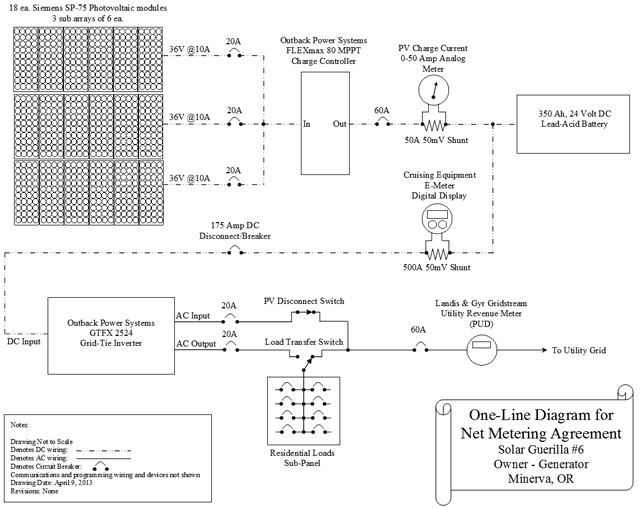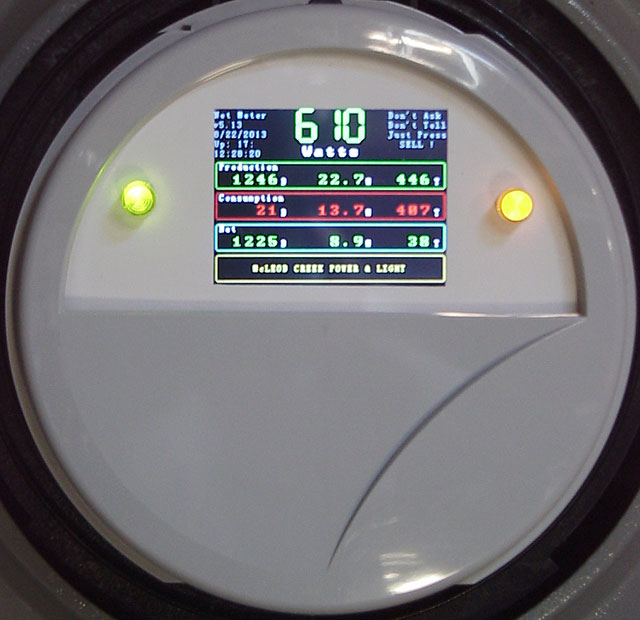Load Control 9
Time out to put some punctuation at the finish of this project.
First, an admission: I was Solar Guerrilla #6, back in Home Power magazine issue 73.
For 14 years, I had been selling my solar generated electricity to the utility by spinning the electric meter backwards during sunny days, effectively offsetting my consumption overnight. Nobody ever noticed, and with the modern electronic inverter that I was using there was no hazard to line crews, etc.
There was a hitch along the way when the utility installed a digital watt-hour meter, this is described in the first of the pages in this series, and was the seed that the load control project grew from.
Then the utility started installing "smart" meters. My experiments on the meter that they installed on my house showed that it reacted to my power production exactly like the previous digital meter, so I just left it alone and continued to build a final, permanent version of the controller, one without all of the loose wires and clip leads.
In early 2013, I got a call from a representative of my electric utility (it's a PUD) telling me that they had detected "reverse energy" on the new smart meter that they had installed the previous summer. When they asked if I knew of a reason for this, like "did I have solar panels," I saw no point in trying to hide, the PV's are mounted out in the yard and all that, so I said, "Yes, but my charge controller was supposed to prevent that from happening."
The caller, who turned out to be the energy services manager, asked if he could come see the installation the next afternoon, and drop off a net metering application. I agreed, expecting that he'd turn around and get back in his car when he found out that it wasn't a county-permitted, licensed-electrician installed, inspected, brand-new-out-of-the-box system.
During his visit he asked about the system generation capacity and anti-islanding protections, and dropped off the six page application, all the while talking like it was a done-deal, just fill out the forms and send them in and he'd rubber stamp them.

I downloaded a PDF of the application, filled it out in Acrobat, drew up a one-line system diagram and a layout drawing showing the spatial relationship of the ground-mounted panels, house, utility meter and service drop, and sent it in via email the day after his visit.
The next afternoon, I got an email back from him telling me the application was approved, and included a copy of the contract signed by them as an attachment.
Crap! It's done!, I'm legal! All I can figure is that the last 14 years wore them down. I ran out the clock and now that they have all these damned smart meters that are ringing bells and flashing red lights down at the administration building, they are bringing everyone they can into the fold so that they can concentrate on more important stuff, like non-payers who are jimmying the meters to cheat.
Amazing! No permits, no inspections, no electricians, and most mind-blowing, no lockable disconnect!
Exactly one week from the inital phone contact, a crew of two workers from the utility's meter shop installed a new smart meter that can recognize reverse energy as net production, Afterwards, I turned off my Frankenstein dump load controller and just let their meter sort it all out. I was catching 99% of the PV excess before, so I didn't expect see a big advantage. Soon, I was in the fourth month of zero-consumption net metering with a 38 kWh surplus.
Of course, I've also spent a fair bit of time since fiddling with my hydro project. If I'm going to get paid for stuffing electrons back into the grid, I'm going to get good at doing it. (they pay wholesale rate for any production over parity at the year-end even-up time)
Because the utilities "smart" meter doesn't calculate the accumulating credit from production-vs.-consumption, I built my own "smarter" meter (known as a "sub-meter because it's on my side of the utilitie's meter) that can track that as well as show an instantaneous readout of the power being consumed or fed back into the grid.

There are six registers:
Daily Production (resettable)
Monthly Production (resettable)
Total Production (accumulating, non-resettable)
Daily Consumption (resettable)
Monthly Consumption (resettable)
Total Consumption (accumulating, non-resettable)
Daily values are displayed as Watthours, Monthly as kiloWatthours to the first decimal, and Total as kiloWatthours.
Additionally, it uses the register values to calculate Net values for Daily, Monthly, and Credit, and displays the results in color-coded numbers, green for Net Production, and red for Net Consumption.
All six registers are stored in non-volatile memory, so they come back after a power failure.
Average Production/Consumption wattage for the last one-Watthour is prominently displayed in either red or green at the top of the display.
The meter has a real-time clock and records power fail and restore times. The yellow area at the bottom of the display is the "messages" area, and is used when resetting the registers, setting the clock, or acknowledging power failures.
The whole thing is designed to be a snap-in "personality module" for an Itron/Schlumberger Centron revenue-grade utility meter base, so it has absolute accuracy and UL listing.
The example above was an earlier version, 5.13, I'm now pretty much finished at v5.21. I built a one-off for my own use now that I'm a legal Owner-Generator, but I fantasize about designing up a printed circuit board and going into production, assuming that others might have some interest in such a device.
If I get bored (it's always possible...), I think about adding WiFi connectivity and writing an app to make the display show up on PC's and mobile devices, or upload data to a server for accumulation and display. It's nuts what's available in the way of modern electronics these days.
So, back in 1999, I was Solar Guerrilla #6, and in 2013, I'm Owner-Generator #19 for the local PUD.
Original material ©1996-2025 Mr. Sharkey | All rights reserved
